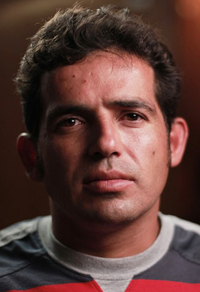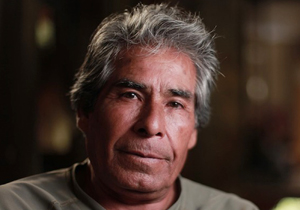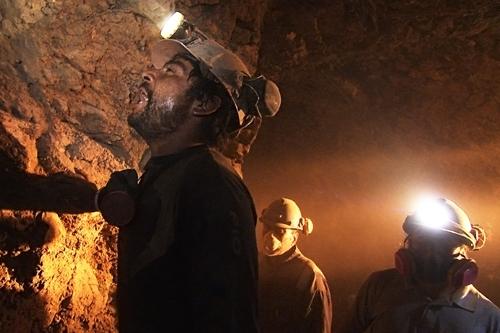On 5 August last year, a cave-in at Chile's 121-year-old San José copper mine left 33 workers trapped more than 2,000ft underground. Their subterranean ordeal would last 69 days, but this documentary concerned itself with the first 17 of those, the period during which the miners had no contact with anybody on the surface and had no way of knowing if they'd be rescued.
The scenes that stuck in the mind at the time were the ones broadcast around the world, showing the extraordinary rescue of the trapped men as they were winched individually to the surface in a tube-like cage after a shaft had been drilled down to them. A miniature city had grown up around the mine entrance, comprising rescuers and their machinery, media, family and friends and politicians, and a fiesta-like atmosphere broke out as the seemingly doomed workers were hauled into the daylight.
Here in Angus MacQueen's documentary, though, we got some inkling of the horrors and terrors that they'd had to endure, which were unsettlingly set up at the start with a quote from one of the miners, Samuel Avalos. "The Devil was with us," he said. "There was an evil presence down there."
This was an accident waiting to happen, since the San José mine was notorious for its poor safety record, and its miners earned unusually high wages in recognition of the fact. Victor Zamora, whose job was to shore up the tunnels, recalled how the mine was wracked by strange noises and had ominous cracks in its walls.
After the chaos and panic of the original catastrophe, which involved a rock fall the size of the Empire State Building as eight levels of the mine workings collapsed, the miners were at least able to drag themselves to an emergency bunker, which in theory offered several advantages. Unfortunately, lax maintenance meant that rescue ladders had rotted away, the escape tunnels were too dangerous to risk, and the supposedly generous food supplies consisted of a few tins of tuna, some crackers and milk. There were enormous quantities of cutlery, though.
 Only six of the trapped men took part in the film, and what they said was fascinating, but you had a powerful sense that what they didn't say would have been even more fascinating. Mario Sepulveda, nicknamed Perry, proved to be a born organiser, and took an iron grip of the meagre food supplies. Tiny but identical portions of tuna mixed with water (there was plenty of water on hand, intended to cool drilling equipment) were doled out to each man with time-and-motion precision, and Perry also organised daily meetings and ensured that all decisions were taken by rigorously democratic vote. Thank God he did, said Avalos, because otherwise he was sure they would have splintered into bitterly feuding factions (miner Alex Vega, pictured right).
Only six of the trapped men took part in the film, and what they said was fascinating, but you had a powerful sense that what they didn't say would have been even more fascinating. Mario Sepulveda, nicknamed Perry, proved to be a born organiser, and took an iron grip of the meagre food supplies. Tiny but identical portions of tuna mixed with water (there was plenty of water on hand, intended to cool drilling equipment) were doled out to each man with time-and-motion precision, and Perry also organised daily meetings and ensured that all decisions were taken by rigorously democratic vote. Thank God he did, said Avalos, because otherwise he was sure they would have splintered into bitterly feuding factions (miner Alex Vega, pictured right).
It was Avalos who let slip that all had not been peace and harmony, when he confessed that he'd selfishly stolen the small supply of saline liquid from the medical kit, and drank it all himself. Avalos also talked about how he was certain they would have devoured the body of anyone who'd died (Alex Vega had become dangerously weak and debilitated and might have been a candidate), and it was a bracing glimpse of what life and death in extreme conditions can really mean. Vega himself described how the group had been haunted by the story of a mining disaster in Mexico, when a cross was erected outside the mine and trapped workers were simply abandoned.
 Happily, the day after even Perry had resigned himself to certain death, the rescuers finally succeeded in getting a drilling probe down to them. But it wouldn't have happened without the dogged campaign waged by Lily Gomez, whose husband Mario was the oldest of the trapped miners (pictured left). She saw that the mining company was going to give up attempting a rescue, gathered some fellow relatives together and set up a protest camp at the mine. Their efforts helped splash the story across the media, and help began arriving from all over Chile.
Happily, the day after even Perry had resigned himself to certain death, the rescuers finally succeeded in getting a drilling probe down to them. But it wouldn't have happened without the dogged campaign waged by Lily Gomez, whose husband Mario was the oldest of the trapped miners (pictured left). She saw that the mining company was going to give up attempting a rescue, gathered some fellow relatives together and set up a protest camp at the mine. Their efforts helped splash the story across the media, and help began arriving from all over Chile.
The rescue was hailed as a miracle, but Lily saw it differently. The 33 had been victims of bad working conditions and poor management, which is why they've launched lawsuits against the mining company and the Chilean Government. They survived, but they aren't the same. "I'd give anything to be the person I was before," said a haunted-looking Victor Zamora.















Add comment